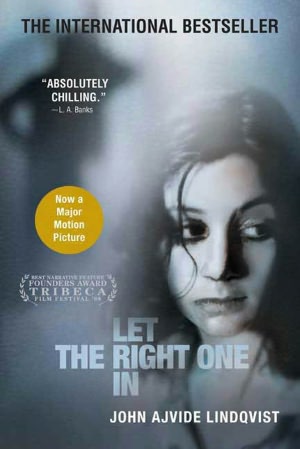
Let The Right One In
by John Ajvide Lindqvist
St. Martin’s Press, 2008
480 Pages
ADULT


“I can’t be your friend,” Eli admonishes at the very beginning, but Oscar is too curious about the smelly new girl to be put off.
Not the usual fare of this site, since it is an adult novel, dealing with complex adult relationships, (and weighing in at a lengthy 500 small-print pages,) but it does center around children as the main characters. This will appeal to adults who enjoy reading YA fiction because really, it’s a paranormal romance and a journey taken by a boy who learns to face his bullies and overcome the challenges of growing up while also learning that love transcends the physical form.
Rather than focusing on a single central character or two, this book deals with groups of characters. This is a book more about the intersections of orbiting relationships that pull people together than it is about a vampire.
Let the right one in, Let the old dreams die, Let the wrong ones go, They cannot do what you want them to do. ~Morrissey
Eli and Hakan move into the same housing complex as Oskar. Eli lives on blood, and like the abomination Claudia from Anne Rice, she is trapped in a little girl’s body. Hakan, though Eli’s caretaker, is a complete failure at killing. Eli has to take it upon herself to find victims, which places her at risk of being discovered. In the end, Hakan makes a horrific sacrifice to protect Eli, but he can’t even die right.
Oskar, the only character who stands alone, is hopelessly bullied, with no self esteem, becomes obsessed with revenge, and pines to someday become a serial killer. His mom is preoccupied with television and the sensational fear it instills of murderers at every subway stop. His father gets drunk and is unable to take care of his own life much less Oskar.
The teens of the complex make another group. Tommy, 16, lives there with his single mom (who is now dating a well-meaning but rigid cop named Staffan) and has a hangout in the complex basement along with his friends Robban and Lasse. Tommy is the one kid who is genuinely nice to Oskar. But he’s having trouble adjusting to his father’s death. He pulls pranks and has a closet full of stolen goods. He does make a tape of Kiss: Destroyer for Oskar, though.
Did he show you his gun?
Then there are the neighborhood drunks from the Chinese Restaurant near the complex in Blakeburg. Larry, Morgan, Karlsson (the only one with a job,) Jocke, who is Eli’s victim early on, and Gosta, a male cat-lady who witnesses a child take Jocke’s life. The group also includes Lacke & Virginia who have a casual relationship they both secretly want to make work someday. Lacke is the real victim, surviving the deaths of the only friends he has in the world, but he is determined to gain revenge on the child-thing that took them from him.
The bullies are the last bunch, Micke and Tomas, who follow Jonny, like to torment Oskar on a daily basement. They call him piggy and make him squeal. Jonny also has an older brother Jimmy, with whom he finds a bond with their estranged father when he lends them an old photo album. Things get out of hand when Oskar torches the album by accident, raising Jimmy’s savage ire.
Stones, sticks. Hit them more than you really dare. Then they’ll stop.
Yes, but what if they…
Then I’ll help you… I can do it, Oskar. That is something I can do.
Lindqvist’s take on the vampirism myth is close to tradition. Eli is good at puzzles and obsessive with detail, and she is extremely sensitive to noise. She can change her appearance to hide fangs and talons, but she can’t enter a place without an invitation. Lindqvist’s vampires are also vulnerable to sunlight, and in one scene, we see that with a kiss, memories can be telepathically transferred between Eli and Oskar. The interesting spin is that after the body dies, after having been bitten but not killed, the turned vampire grows a new brain in its heart before rising again. One part I found more surreal than classic vampirism was when Oskar sees a drop of blood move like a serpent, a scene I think might better have been cut.
She was bleeding out all of the pores in her body.
Oskar caught his breath, shouted: ”You can come in, you can… you are welcome, you are …allowed to be here!
Eli stays twelve mentally as well as physically. I am glad Lindqvist gave us a conversation that addressed her age, because by the point it comes about I was really wondering whether Eli was a wizened Machiavellian predator out to use Oskar the way she used her caretaker Hakan in a long line of those whom she had used up and spit out like so much raw meat. I am still not convinced, but I’d like to believe that Eli has genuine feelings for Oskar at the end, that they understand each other’s need for blood, pure love, and puzzles.
Luckily we may find out soon. Linqvist is including a follow-up story involving these characters in his new collection of short stories: Let the Old Dreams Die. It has been out in Europe for some time now, but the English translation was released this week. Unfortunately, it is only available in the UK, not yet in the US directly. (Thank you, amazon.co.uk.)
The graphic, perverse sexual imagery of Hakan anchored the story in the realm of the disturbed and acted as a reminder that the love developing between Eli and Oskar was unnatural at best.
If you got away with it. If it just happened. If you could wish someone dead and they died. Wouldn’t you do it then?
…sure.
Sure you would. And that would simply be for your own enjoyment. Your revenge. I do it because I have to. There is no other way.
I did get lost when various prices were mentioned in terms of Swedish Kronor, and I was forced to look up the current exchange rate. Given this takes place in the late 70s, when both the author and myself were about the same age as Oskar and Eli, this still offers a ballpark:
Stolen Walkman: SEK 50 (USD $7.50) Liaison at Stockolm Library: SEK 500 (USD $75.00) Kiss: Destroyer (taped by a friend): Priceless! |
The book is filled with father symbolism, from Hakan’s position of caretaker to
Tommy’s use of his step-father’s gun trophy to kill an attacker. Oskar’s runs away from his dad’s house because he just can’t stand to deal with his being drunk, choosing the bottle and his drinking buddy over his son. Not when he has a choice. Even at Eli’s turning, we see her mother washing clothes, (which I still don’t understand,) but her father is absent. Tommy and Oskar’s mothers are present, but the strong relationship issues with all the kids seem to be with dad.
I did find the book to be unnecessarily long, in fact (you’ll never see me saying this about any other movie adaptation) the movie version does well in telling the story, keeping the meaning and emotion intact, while cutting the exploration of side stories. After reading the book, I watched movie again, and was impressed. I almost wished the book had kept more to the lines of the movie. The separate stories of Lacke and Virginia, Hakan and what happens after his “accident,” and Eli’s back story all could have been cut to make the book move faster, but then I suppose that’s the difference between a “foreign film” and Hollywood.
I enjoyed this story so much I went back to compare Let Me In, the American movie adaptation, and the original Swedish version. (Why, Hollywood, why?) In much the same way as The Ring and The Grudge (Ringu / Ju-On) were Americanized, the re-make can’t hold a candle to the original film.
I also have to mention the CGI effects. The highly enjoyable Swedish film showed Eli climbing up to Hakan’s top-floor hospital room on the outside as the only “special effect.” It was filmed with a live stunt person on a rope. Later, when she jumped over to her window from Oskar’s bedroom, we saw only a flutter of towel, then a shot establishing where she had jumped. I loved this subtlety. In the US version, Eli attacks a man under a bridge, but it isn’t Eli, it’s a cartoon– no better than Jessica Rabbit or Gene Kelly dancing with Jerry the mouse. When the effects are this bad (like the movie Underworld) they become a contrivance that pulls you out of the story and makes you sadly wish you had just read the book.
I do wholeheartedly recommend that you read the book. It is a deeply involved, scary story, intensely and chillingly emotional.



